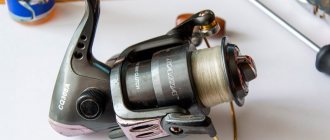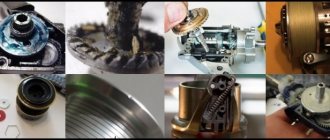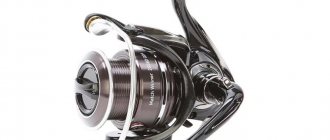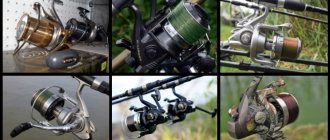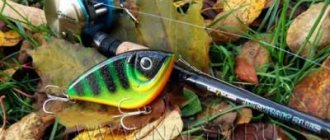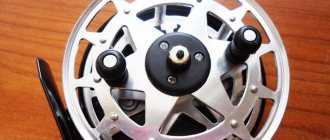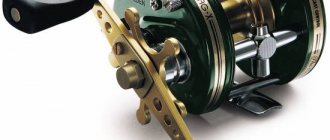The popularity of spinning reels among Russian spinning players is now higher than ever. The time of the so-called “wheels” (that is, simple inertial coils) has already passed, and the time of multipliers, despite the steady growth of their popularity, has not come, and, you can be sure, will never fully come. It is not surprising, therefore, that a significantly large part of the questions asked about reels in general relate only to “inertia-free” machines, which are popularly called “meat grinders”.
And yet, how necessary is the “worm” in the reel mechanism?
The vast majority of the reels that I have been using in recent years have a “worm” (aka an endless screw). The need for its presence depends largely on the fishing method and the type of bait. If, for example, you only fish with spinners, crank wobblers, or, using the classic method, with jigs, then you should be completely satisfied with a high-quality reel without an endless end. In the case when you practice those types of fishing that require a jerking technique of wiring, and the tension of the fishing line during the winding process is very variable, the absence of a “worm” can have the most negative effect - “beards” will fly off every now and then.
Moreover, purely externally, winding on reels of adjacent series, but with and without a screw, may be almost the same, however, when fishing, say, with poppers, the difference in the operating advantages of such reels will appear very soon. I have, for example, “Zester” and “Exia”. There are practically no visual differences in the winding profile of either reel, and in terms of fishing, as long as it concerns “spinners” or jigs, too. But once you put in a minnow wobbler and start fishing using the “twitching” method, the difference is sure to show up: “Exia”, if it drops a small “beard,” will only be once or twice per fishing, whereas with “Zester” this will happen several times times more often. So decide for yourself - depending more on your preferences for bait and wiring technique - how necessary a reel with a “worm” is for you.
I'm not happy with the winding profile on the reel. What can be done?
I discussed this issue in detail in one of the issues of the magazine “Fish with us!”, as well as in the book “Winter Spinning”. So I can redirect you to one of these publications. In addition to the methods described there for adjusting the laying of the fishing line (using “negative backing” and bobbin washers), sometimes the desired result can be achieved in a simple and somewhat unexpected way - by turning the roller 180°. We are talking about an asymmetrical video made like a “twist buster”. Rollers of this type help reduce the twisting of hard (mostly monofilament) fishing lines; they are ineffective for soft cords. Therefore, by turning the roller over with a cone in the opposite direction, you won’t lose much, but the laying profile may well become more even. I myself don’t fully understand what the reason is, but on a couple of reels I was able to achieve improved cord laying using this simple technique.
Shallow and deep spools - which is better?
Until a certain time, spools of small line capacity (for reels of considerable size) were considered “match”, that is, intended for float fishing. Then, in the assortment of serious companies (Daiwa, Shimano), purely spinning reels with very small spools appeared. These are reels of the so-called “sports” class. Our first reaction to low-capacity coils was very negative. Yes, they are designed almost exclusively for braided cords, but even very thin braided spools on such reels rarely last more than a hundred meters. Many quickly realized that the lifespan of a piece of cord even 135 m long is not 35% longer than that of a 100-meter one. and almost twice. Therefore, a 100-meter unwinding was quite rightly considered irrational, and, accordingly, low-capacity reels were considered not to correspond to the ideal. As a compromise option, if you remember, they offered to purchase an additional deeper spool from Emblemka for the Tim Daiwa reel... Then “public opinion” changed somewhat and they began to treat low-capacity spools with greater understanding. This was not least due to the fact that the perception of what should be called “thin braid” became slightly different.
If we discard the coarse rope-like cords (albeit sometimes with stated diameters of 0.12 mm or so), then it turns out that on the spool, for example, a TD MgS 1000 reel, one hundred and thirty meters of high-quality thin “thread” can easily fit - such as, for example , Pro-Jig. In this situation, “sports” type reels perform at their best, and there is no longer any need to talk about irrationality. I have heard from several people that braid still has the property of “rotting,” that is, deteriorating if it is left wet on the spool for a long time. This, although it contradicts the property of complete inertness of their fibers to water and substances dissolved in it, declared by the manufacturers of braided fishing lines, and is not confirmed by my own experience, still leads to certain thoughts. You may have noticed that if you have a large piece of braided fishing line wound onto a deep spool, then over time the laying of its lower layers acquires a wave-like structure. If we were talking about monofilament, then this could be explained by changes in its length in a wet and dry state. Theoretically, this should not happen with “braid,” but doubts remain, and therefore very deep spools, a good half of the capacity of which are used exclusively as a “warehouse” for the unused part of the cord, are perhaps also not the best option. The optimal spool, in my opinion, will be one that can hold about one and a half hundred meters of the cord that you intend to use most often. Here, it’s probably worth noting once again that you definitely shouldn’t rely on the line capacity indicated on the spool and the formal diameter of the cord - otherwise problems may arise.
How to choose a reel for ultralight
A good ultralight reel should have the following qualities:
- be suitable for using thin lines and light baits;
- work well with the rod and fit it;
- have high performance of the device with joint ease of use;
- have good sensitivity of the friction brake with the ability to regulate it.
In order to choose the right reel for ultralight, you need to pay attention to the following characteristics:
- size;
- weight (no more than 300 g);
- clutch;
- laying fishing line;
- bearings;
- coil stand;
- line roller;
- reel spool;
- smooth running of the reel;
- instant reverse stop;
- body material.
Size
The size of an ultralight reel is determined by the size of its spool. They range from 1000 to 2500. The most universal spool size is considered to be 2000.
Weight
The weight of an ultralight reel is one of its main criteria. The following rule applies to this device: the less weight the coil has, the better.
If the reel weight is incorrectly selected, the following difficulties may arise:
- a reel that is too heavy compared to a weak rod can lead to its breakage;
- tackle with a reel that has a disproportionate weight will be inconvenient to use and ineffective, since the overall balance will be disrupted;
- due to uneven loads through the heavy weight of the reel, problems with the controllability of the rod may occur.
Today, modern manufacturers reduce the weight of ultralight reels in two ways:
- using new technologies and materials that can guarantee reliability;
- using available raw materials, the quality of which cannot be guaranteed by any manufacturer.
The difference between these manufacturing techniques is not only the reliability of the materials, but also the price. But ultralight gear is mainly used by professional fishermen, so saving on such things would be unwise.
There are some classic ratios, following which you can choose the correct weight of the reel:
- for spinning with dough up to 3.5 g, a reel is selected with a weight of up to 160 grams;
- for spinning with dough up to 5 g, a reel is selected with a weight of up to 200 grams;
- for spinning with dough up to 8 g, a reel is selected with a weight of up to 220 grams.
Friction clutch
The main task of the clutch is to remove the load from the fishing rod at the right time and prevent breakage of the tackle.
Friction brake type
The types of friction brake of reels are:
- In front of them;
- rear
Experts recommend using the front type of friction brake, since it is more sensitive and is more convenient to use than the rear type of clutch.
Friction brake quality
The quality of a friction brake is usually determined by only two main criteria: settings and sensitivity.
Features of the settings are determined by the number of modes and the degree of force applied to operate the brake.
Brake sensitivity is the ability to respond quickly at the right moment.
In addition, an additional criterion for a friction brake is its behavior during operation. It should not make strange jerks or sharp clicks, but should work quickly, but at the same time smoothly.
If you have doubts about the operation of the friction brake, then such a reel should not be purchased.
Line laying
The nature of the line laying is a very important criterion when choosing a reel.
The following points depend on the method of laying the fishing line:
- laying the line affects the length of the cast;
- laying the fishing line affects the overall performance of the clutch;
- affects the shelf life of the fishing line itself.
Characteristics of proper line laying:
- there should be no dents or mounds on the plane of the layered fishing line;
- there should be no conical winding shape;
- The rings of the fishing line should not cross previous layers of turns.
As a rule, poor line lay can be observed with inexpensive, low-grade reels. Mid-class and luxury-class reels do not have such defects.
Bearings
Bearings perform the following roles in the reel mechanism:
- minimize backlash;
- ensure proper operation of the reel mechanism;
- ensure the reliability and durability of the reel.
Some anglers believe that the more bearings, the better the quality of the reel, but this opinion is wrong. For the normal functioning of the ultralight reel, 6 bearings are enough. A large number of bearings (8, 10 or more) are needed only when the coil will be heavily overloaded.
Reel stand
It is advisable to purchase a reel stand that is as long as possible, since reels with a short stand allow you to literally hit the rotor on your fingers as it rotates. In addition, the stand must be selected for the individual hand of the fisherman, since the owner should not experience any inconvenience when using it.
Line roller
Since the line roller is one of the most important elements of the reel, it must have all the characteristics described below:
- it must be durable and covered with two layers of wear-resistant coating;
- It spins well and spins under the pressure of the fishing line that is moving. If the roller does not move clearly, then there will be cuts, which in the future can lead to big problems with the reel;
- it should be well lubricated and spin easily on the bearing.
If at least one criterion does not work as it should, then you should not purchase such a reel, so as not to make a mistake in your choice.
Reel spool
The reel spool must be made of the following materials:
- aluminum (best option);
- metal (allowed);
- graphite (extremely rare).
The correct ultralight reel spool should have the following qualities:
- the side of the spool must be very hard and covered with titanium nitride;
- the spool should be shallow;
- the line should be wound almost under the side, covering the spool completely.
Smooth reel running
The smooth running of the coil primarily indicates the suitability of the entire device as a whole, good lubrication and operation of the bearings. When purchasing a high-quality reel, it should start working smoothly from the first spin. If this does not happen, then you should not listen to advice that it will develop over time, since, as a rule, the coil immediately expresses itself without any development.
Instant reverse stop
Instant reverse stop is an integral feature of a high-quality ultralight reel. It is needed for complete control of the tackle when leashing, quick hooking and preventing the line from unwinding. Of course, this is a minor function in the reel, but with it it will be much easier for the fisherman to make a catch.
Housing material
Sufficient care should be taken to select the housing material. It is highly undesirable for it to be made of plastic or various alloys. The best material for the reel body is considered to be metal with a special marking Air Metal.
What should you pay attention to first in the operation of the reel clutch?
If we are talking about cheap reels with a front clutch, then you need to make sure? that the adjusting nut does not tend to self-tighten. Having established a certain value of the tightening force, try to rotate the spool in the direction in which it would turn when releasing the line. Then do the same with two or three more values of tightening force. On some reels, the adjusting nut tends to rotate along with the spool, thereby increasing the tightening force against our will, which ultimately leads to the line breaking on the fish. Such reels should be strictly avoided. Some “meat grinders” (with an emphasis on power parameters) have difficulty adjusting the tightening force in the area of low values. In principle, there is nothing particularly unpleasant about this - you just need to keep in mind that fishing line with a strength below a certain level should not be wound on such reels.
How permissible is it to use components from one reel model in another?
For some models this is not only justified, but also advisable. For example, among Banax reels there are two series - Saint and Cion. The first of them can be used as an illustration of what was said just above - the clutch does not always turn on in time if the strength of the cord is less than 4 kg. But the clutch of the slightly more expensive Cion reel is made of better quality and there are no problems in its operation. Therefore, having purchased a reserve spool from “Sion”, you can use it with relatively thin cords on the “Saint”, leaving its “native” spool for a stronger cord. As for other options for using spare parts from different models of “meat grinders,” they are also quite acceptable. Therefore, you should not throw your outdated coil in the trash - some of its “organs” can be successfully “transplanted” to other coils if the need arises. This could be, for example, a handle (the geometry of its seat very often coincides), a bow spring, bearings... It is these elements that most often fail, and a long-dead reel can successfully manifest itself as a “donor”. What is significant is that we are often talking about models from fundamentally different companies. I will only list the names of those among which I have successfully exchanged parts. These are coils from Shina, Quantum, DAM, Banax, Mitchell...
Features of choice
You can experience all of the above advantages in practice only by installing the correct coil. The question of choosing such a tool arises not only among beginners, but also among more experienced professionals. At the same time, many disagreements, theories and thoughts wander around him. So how to choose good tackle if there are no clear opinions. The answer is obvious - evaluate the main selection criteria and avoid mistakes at the purchase stage.
The first thing you should pay attention to:
- Coil sizes.
- Gear ratio.
- A type of friction brake.
- Number of bearings.
- Availability of additional functions and capabilities.
As for the size, this parameter plays a vital role when choosing a reel, especially if the task is to find a part for a lightweight blank. Ultralight spinning rods do not combine well with heavy reels, since such products disrupt their balance, stability and sensitivity. To choose the right option, you should clarify the exact size, which is compiled according to the Shimano classification in increments of 500 units.
Once the appropriate dimensions have been selected, you can begin to consider the gear ratio. Regardless of the type of reel, its design contains several gears that transmit rotational force from the handle to the rotor. The number of rotations of the rotor is determined by the size and pitch of the teeth. This ratio is called the gear ratio. The higher this indicator, the faster the unwinding of the fishing line or braided cord will occur.
However, excessive speed causes low pulling properties, so such models are not suitable for working with heavy baits for jigging and twitching. If you fish with heavy wobblers or spinners using a high-speed reel, this will destroy it within one season of use. A universal solution for such conditions will be an inertia-free powerful reel, the gear ratio of which is 4.8−4.9:1. It is advisable to give preference to Japanese or American goods.
Clutch and bearings
Each reel has a special friction brake, which is designed to automatically release the line when fishing for prey. The main requirement for such a unit is the ability to perform its task smoothly, clearly and efficiently without biting, failing or jamming. Of course, budget developments do not meet such criteria, but products from leading brands from Europe, Japan or the States perform with a bang.
However, even budget inventions from the Middle Kingdom have improved well in terms of production quality, so they also deserve attention. As for the type of clutch placement, it can be divided into two conditional groups:
- Front,
- Rear.
In the first case, the adjuster nut is located in the upper part and serves as a spool fixation. The advantages of the model include its compact size and wide possibilities for changing operating parameters.
Devices with rear clutch have a modified design. In this case, the washer located on the back of the product is responsible for bleeding the fishing line. The disadvantages of such models are their large size and weight, as well as the presence of several mechanisms that increase rapid wear.
The functionality of any spinning reel also depends on the quality of the ball or roller bearings. The purpose of such elements is obvious - they are intended to reduce the load on the product when working with bait and fishing for prey. In addition, the bearings relieve the main components from excessive friction, providing maximum smoothness.
At the moment, even budget developments have 2-3 bearings at their disposal, while more advanced devices have 10-15 “balls” at once. But too many bearings also have a downside, because sometimes they do not cope with their tasks, but only increase the weight and size of the reel. According to the manufacturers of the popular XFY spinning reels, which have long won the hearts of fishermen with their quality, 5-7 bearings are enough for comfortable fishing. If there are more of them, they turn into unnecessary “ballast”.
Additional functions and material of manufacture
In addition to the basic functions and features, advanced spinning reels can support a number of unique elements that have a positive impact on the performance of the system, especially under heavy loads.
Among the most unique additional features:
- Titanium nitride coating of the line laying roller. The presence of such an element allows you to use both monofilament fishing line and braided cord without the risk of damage to the gear on the sharp edges of the metal knot. By the way, in expensive models, the spool collar is also coated with titanium nitride, which has a good effect on casting distance.
- Support instant reverse stopper. It is very good if the reel stops quickly after the handle stops turning. This parameter is indispensable when fishing with jig or twitch baits.
- The presence of a system for leveling the spool stroke at dead points, which has a positive effect on the quality of fishing line winding.
Most modern reels are made from high-quality raw materials, which are characterized by good performance, reliability and durability. When choosing a suitable manufacturing material, you need to pay more attention to the weight of the structure and resistance to mechanical stress.
Models from the middle and budget price segment can be made from various magnesium-aluminum alloys, which are characterized by increased strength and ergonomic dimensions. Graphite or carbon designs are also popular.
The need to buy light reels arises among connoisseurs of fishing with light baits, because in such cases, every gram of weight can play a big role.
Some models of “meat grinders” from different companies look very similar. Is this a coincidence?
In fact, sometimes you pick up a fishing magazine, open it to different advertising pages and it’s like solving a “find the five differences” puzzle. And you find some - in the name, sometimes in the color... A couple of years ago I even set myself the goal of counting under how many trademarks in our country one very specific model of a Chinese spinning reel was offered. The result was number six. It is possible that I missed something. This practice is accepted all over the world, but perhaps there should be a reasonable limit. Companies that order reels under their logo from a standard model range offered by a real manufacturer are among them.
The level of their gear is very low, and the ratio between price and quality leaves much to be desired. I could name typical figures - the selling price for this or that reel model and the retail price, but I won’t do this so as not to spoil anyone’s mood. The retail price for such reels is still low, which is why they are in demand. There is a more respectable option. This is when a company orders coils from a manufacturing plant, taking into account its own developments and without the right to sell under other brands. More reputable “brands” go this way - Mitchell, DAM, etc. Accordingly, the reels fall mostly into the middle price range with a good price-quality ratio. Finally, the option when a physical manufacturer sells its coils under its own brand gives the most optimal value for this key parameter. Another thing. that there may not be reels with the characteristics you are interested in in the model range of such a company. Well, if there is, then, of course, it’s better to take a reel from Okuma or Banax than its slightly repainted “twin” with a different label at a higher price.
Differences from multipliers
Today we can confidently say that inertial-type coils are nothing more than a thing of the past. Using them in real fishing conditions is not entirely convenient, since such devices do not have the ability to automatically stop their movement, and this complicates the process of placing the bait and landing fish. “Inertia” can become useful in rare cases, for example, for fishing with bottom gear. In all other respects, they are much worse than modern spinning reels.
Since the advent of spinning reels, the attitude of anglers towards spinning reels has changed significantly.
These products have made fishing as comfortable and efficient as possible, due to their light weight, high sensitivity and good gear ratio. In addition, even a novice angler who has no experience in fishing can learn how to handle inertialess models.
As for multipliers, or “sea” reels, they are intended for a narrow circle of professional fishermen who are forced to cope with maximum loads when fighting with the heaviest predators.
Multipliers will become a useful tool in cases where inertia-free ones are simply powerless. It is not wise to buy them as your first reel.
